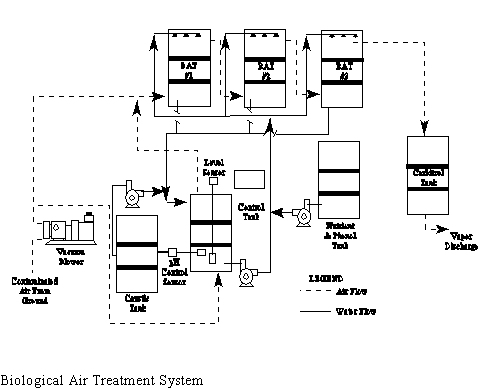
ALLIEDSIGNAL ENVIRONMENTAL
SYSTEMS AND SERVICES, INC.
(Biological Air Treatment System)
TECHNOLOGY DESCRIPTION:
AlliedSignal Environmental Systems and Services, Inc. (AlliedSignal), has developed a biological air treatment (BAT) system that purifies contaminated air streams (see figure below). This system uses a biomass support matrix consisting of porous polyurethane foam with a surface area-to-volume ratio greater than 200 square feet per cubic foot. This support matrix is coated with powdered activated carbon (PAC) using a proprietary procedure that maintains the carbon in an activated state.

The carbon-coated foam support matrix is then mixed with polypropylene spacers, yielding a "mixed media" packing. The mixed media packing gives the support base rigidity and provides spaces between adjacent carbon-coated porous foam blocks. This open spacing gives the BAT system good distribution and mass transfer characteristics. It also results in low back pressures at gas retention times as low as 30 to 60 seconds.
The BAT's unique support matrix has been used in conjunction with spacers such as HiFlow pall rings, which enable the BAT system to achieve removal rates greater than 92 percent for benzene, toluene, ethylbenzene, and xylene (BTEX). These removal rates have been achieved at loading rates up to 60 grams BTEX per cubic meter per hour while maintaining back pressures of less than 4 pounds per square inch at a linear minute space velocity of 0.5 minute.
Moisture content, nutrient levels, and pH are controlled by introducing a slow downward flow of water countercurrent to the air flow. The water then exits the reactor and enters a small holding reservoir where the pH of the water is monitored and automatically readjusted to pH 7. The water can then be recycled to the reactor. High initial organic loading rates result in considerable acid generation, and pH control is essential. Nitrogen (in the form of ammonia or nitrate) and phosphate nutrients are monitored and added to the reservoir to ensure that organic pollutants continue to biodegrade. The conductivity of the water in the reservoir is also monitored, and a portion of the water is periodically replaced to prevent buildup of dissolved salts.
The BAT system can be applied to any air or vapor exhaust system that contains biodegradable organic contaminants, including aromatic hydrocarbons such as BTEX and naphthalene, as well as biodegradable chlorinated organics such as trichloroethene (TCE). Several commercial BAT units are being used to treat exhaust gases from creosote wood preserving operations. These systems have reduced total volatile organic compound emissions by more than 90 percent and have dramatically reduced odor problems at these sites. Other applications include treatment of soil vapor extraction systems, commercial bakeries, pharmaceutical plants, food processing plants, and chemical plants.
STATUS:
This technology was accepted in the SITE Demonstration Program in 1995. The BAT system is being demonstrated at the AlliedSignal St. Joseph, Michigan Superfund site. Demonstration activities began in August 1995 and will continue through fall and winter 1996. The technology is being used in conjunction with a soil vapor extraction system to remove TCE and other chlorinated ethenes.
FOR FURTHER INFORMATION:
EPA PROJECT MANAGER:
Ronald Lewis
U.S. EPA
National Risk Management Research Laboratory
26 West Martin Luther King Drive
Cincinnati, OH 45268
513-569-7856
Fax: 513-569-7105
TECHNOLOGY DEVELOPER CONTACT:
Stephen Lupton
AlliedSignal Environmental
Systems and Services, Inc.
50 East Algonquin Road
P.O. Box 5016
Des Plaines, IL 60017-5016
847-391-3224
800-462-4544
Fax: 847-391-3750
TECHNOLOGY VENDOR CONTACT:
Andra Moffett
AlliedSignal Environmental
Systems and Services, Inc.
P.O. Box 1053
Morristown, NJ 07962-1053
201-455-5894
800-626-4974
Fax: 201-455-5722